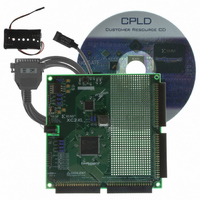DO-CPLD-DK-G Xilinx Inc, DO-CPLD-DK-G Datasheet - Page 105

DO-CPLD-DK-G
Manufacturer Part Number
DO-CPLD-DK-G
Description
KIT DESIGN CPLD W/BATT HOLDER
Manufacturer
Xilinx Inc
Series
CoolRunner™- IIr
Type
CPLDr
Specifications of DO-CPLD-DK-G
Contents
Proto Board, Download Cable, Samples, Software
For Use With/related Products
CoolRunner-ll, XC9500XL
Lead Free Status / RoHS Status
Lead free / RoHS Compliant
Other names
122-1512
Available stocks
Company
Part Number
Manufacturer
Quantity
Price
- Current page: 105 of 144
- Download datasheet (4Mb)
Programmable Logic Design
June 12, 2006
R
17. Click OK.
18. Save the Constraints Editor session (File
CoolRunner-II architecture supports the use of non 50:50 duty cycle clocks by
implementing input hysteresis. This can be selected on a pin-by-pin basis. For example, if
the clock used in this design is an RC oscillator, the input hysteresis can be used to clean up
the clock using the following constraint syntax:
The CoolRunner-II CPLD also supports different I/O standards. If the three light signals
had to go to a downstream device that required the signals to conform to a certain I/O
standard, you could use the following constraint syntax:
The permissible standards are LVTTL, LVCMOS15, LVCMOS18, LVCMOS25, LVCMOS33.
On larger devices (128 macrocell and larger), the permissible standards are HSTL_I,
SSTL2_I, and SSTL3_I. However, you can use only one I/O standard per bank, so take care
when assigning different I/O standards in a design.
The CoolRunner-II family has several features that are aimed at reducing power
consumption in the device. One of these features is known as CoolClock. The clock signal
on Global Clock Input 2 (GCK2) is divided by 2 as soon as it enters the device. All of the
registers clocked by this clock are then automatically configured as dual-edge triggered
flip-flops. The highest toggling net in the design will now be toggling at half the frequency,
which will reduce the power consumption of that net without compromising the
performance of the design. The CoolClock attribute can be applied by right-clicking on
GCK2 in PACE or by adding the following line in the UCF:
Notice that the Clock to Pad fields have been filled in automatically and that the UCF
generated has appeared in the UCF constraints tab at the bottom of the screen.
The UCF file should look similar to
Editor.
NET “clock” schmitt_trigger;
NET “red_light” IOSTANDARD=LVTTL;
NET “clock” COOL_CLK;
Figure 5-12: Complete Constraints List
www.xilinx.com
Figure
5-12.
→
Save) and exit the Constraints
Constraints Editor
95
Related parts for DO-CPLD-DK-G
Image
Part Number
Description
Manufacturer
Datasheet
Request
R

Part Number:
Description:
STARTER KIT CPLD
Manufacturer:
Xilinx Inc
Datasheet:

Part Number:
Description:
KIT STARTER CPLD JAPANESE
Manufacturer:
Xilinx Inc
Datasheet:

Part Number:
Description:
KIT STARTER CPLD-JAPANESE
Manufacturer:
Xilinx Inc
Datasheet:

Part Number:
Description:
IC CPLD .8K 36MCELL 44-VQFP
Manufacturer:
Xilinx Inc
Datasheet:

Part Number:
Description:
IC CPLD 72MCRCELL 10NS 44VQFP
Manufacturer:
Xilinx Inc
Datasheet:

Part Number:
Description:
IC CPLD 1.6K 72MCELL 64-VQFP
Manufacturer:
Xilinx Inc
Datasheet:

Part Number:
Description:
IC CR-II CPLD 64MCELL 44-VQFP
Manufacturer:
Xilinx Inc
Datasheet:

Part Number:
Description:
IC CPLD 1.6K 72MCELL 100-TQFP
Manufacturer:
Xilinx Inc
Datasheet:

Part Number:
Description:
IC CR-II CPLD 64MCELL 56-BGA
Manufacturer:
Xilinx Inc
Datasheet:

Part Number:
Description:
IC CPLD 72MCRCELL 7.5NS 44VQFP
Manufacturer:
Xilinx Inc
Datasheet:

Part Number:
Description:
IC CR-II CPLD 64MCELL 100-VQFP
Manufacturer:
Xilinx Inc
Datasheet:

Part Number:
Description:
IC CPLD 1.6K 72MCELL 100-TQFP
Manufacturer:
Xilinx Inc
Datasheet:

Part Number:
Description:
IC CPLD 72MCRCELL 7.5NS 64VQFP
Manufacturer:
Xilinx Inc
Datasheet:

Part Number:
Description:
IC CPLD 1.6K 72MCELL 100-TQFP
Manufacturer:
Xilinx Inc
Datasheet:

Part Number:
Description:
IC CPLD 1.5K 64MCELL HP 44-VQFP
Manufacturer:
Xilinx Inc











